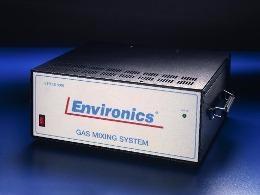Gas chromatography is an innovative approach to separating and quantitating vaporized compounds through the use of an inert carrier gas.
Gas chromatography functions according to similar principles as column permeation chromatography, whereby a sample will be dissolved in a mobile phase before being passed through a porous stationary structure.
By the time they have eluted from the permeable column, compounds can generally be characterized and quantified. This factor will be determined by multiple characteristics, for example, hydrodynamic behavior, molecular weight and concentration in the mobile phase.
The key difference between gas chromatography and standard chromatographic methods is the utilization of a vapor (as opposed to a fluid) as a mobile phase and a liquid (as opposed to a solid) as a stationary phase.

Image Credit: Environics Inc.
How Gas Chromatography Works
Non-reactive gases are utilized as a carrier for vaporized molecules of interest. Helium (He) and hydrogen (H) are commonly used in this process. The gaseous mixture will be flowed through the column of a gas chromatograph, which generally consists of a microscopic fluidic membrane along with an inert, solid substrate.
This column will then partition vapors based on both their affinity with the stationary fluid and their mechanical properties. Flow-through rates of the sample’s constituent parts can then be used to gain valuable insight into the compound’s properties, as well as for the identification, quantitation, compound detection and purification.
In gas chromatography, elution is electronically monitored by employing a detector placed at the permeable column’s outlet stream. This detector will measure the retention time (tR) of compounds, allowing users to qualitatively determine their adsorption characteristics with packing media of specific chemical compositions.
Gas Chromatography Challenges
Effective detector calibration remains an ongoing challenge in gas chromatography. A wide range of detector types is integrated with gas chromatographs, for example, flame ionization detectors, mass spectrometers and thermal conductivity detectors.
Each of these systems will function according to specific principles and must therefore be appropriately calibrated to detect exceptionally small gas concentrations in real-time with high selectivity.
Ensuring the performance of gas chromatography calibration relies on the use of specialized gas mixers to generate a test mobile phase with suitable concentrations.
Typical gas chromatography studies require mass accuracy levels in the parts per million (ppm) and parts per billion (ppb) range, depending on the application area in question. It is also important that mixers be able to match the desired pressure ranges and thermal mass flow rate of test conditions.
Gas Chromatography Solutions from Environics
Environics has many years of experience in the production of gas mixers, dividers and diluters for gas chromatography calibration.
The company’s Model 4000 systems offer as much as ten times more accuracy than conventional thermal mass flow meters, and these instruments can also be customized to accommodate the specific properties of gases of interest.
This combination of accuracy and flexibility facilitates reliable detection of compounds of interest, as well as preparatory observation of concentration levels, allowing users to establish an accurate and repeatable calibration curve.
Environics’ Zero Air Generators (ZAG) have been designed to ensure ultimate flexibility and cost-effective calibration of gas chromatographs.
They are able to provide a continuous stream of contaminant-free air at flow rates of 20 liters per minute (SLPM), with pressures of 30 psi. This is possible, either as a stand-alone system or when using an existing compressed air source.
The company’s range of systems for gas chromatography calibration includes:
- Series 4000 Multi-Component Gas Mixing System
- Series 4020 Computerized Gas Mixing and Dilution System
- Series 4040 Gas Dilution System
- Series 7000 Stand-Alone ZAG

This information has been sourced, reviewed and adapted from materials provided by Environics, Inc.
For more information on this source, please visit Environics, Inc.